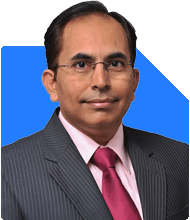Janak Patel |71 Answers |Ask -Follow
MF, PF Expert - Answered on Apr 25, 2025
He is the CEO and founder of InfiniumWealth, a firm that specialises in designing goal-specific financial plans tailored to help clients achieve their life goals.
Janak holds an MBA degree in finance from the Welingkar Institute of Management Development and Research, Mumbai, and has over 15 years of experience in the field of personal finance. ... more

Hello Sir, I have a query regarding which is right approach of mentioned two options -I want generate quarterly payout of 15k from a lumpsum investment of 5.5 lac. This is for paying school fees. I'm confused if to invest tthis lumpsum in a Balanced advanced fund and set up an SWP of 15k quarterly (OR) to put it in a non-cumulative FD that pays out quarterly interest. I'm okay to stay invested for 6 years. Although FD provides the capital preservation but lags in capital appreciation where as BAF has the risk but with time horizon of 6 years, it shall mitigate risk & most importantly returns will still be favourable due to equity component as kicker in BAF Mf's. Your thoughts please... Thank you
A good question which I get asked by many parents for a similar requirement.
Both options as you have pointed out have their out pros and cons. The Risk/Return equation is always going to weigh on the decision making.
At 6~7% return on an FD, we are considering approx. 10 lakhs amount for investment and its not a small amount by any means.
The Balanced Advantage Fund (BAF) has a debt component and that provides a certain level of stability/downside protection to the investment.
Usually we always associate short term requirements with safety and liquidity requirements and longer term investments with growth. Having said that, this cannot and should not be taken as just 1 and only individual investment for a person.
Because if we do that then, logic suggests a conservative approach with FDs as its the child school fees and we cannot default in its payment.
I will give you the options I think will help you make the decision.
1. Are you of a very conservative person when it comes to taking risk with your money ?
If you think you can sleep peacefully knowing that the school fees will be paid no matter what as its kept in a safe and liquid investment like FD then please stay with FD.
This is also a scenario for individuals who do not have a steady stream of income and many factors influence their income source or individual who have very limited investments.
2. Do you have other investments which can supplement any market volatility on this investment ?
If you think that you have other investments which can supplement the school fees if the market becomes volatile and you understand that in the long term the equity portion of the investment is what you want to provide that extra return. This understanding and acceptance of risk provides you with assurance that you can stay committed to your approach, then and only then proceed with equity linked investment.
This scenario doesn't reflect you as being risky with your money, but rather an approach where you embrace the volatility and have confidence to manage your money for the long term. So a BAF is a good approach.
So in summary your own risk taking ability and your investment portfolio should help you plan the right approach. At the end of the day its what will give you assurance for the future that matters the most.
Thanks & Regards
Janak Patel
Certified Financial Planner.
You may like to see similar questions and answers below
Omkeshwar Singh | Answer |Ask -Follow
Head, Rank MF - Answered on Jan 07, 2022
Milind Vadjikar | Answer |Ask -Follow
Insurance, Stocks, MF, PF Expert - Answered on Jan 24, 2025
Ramalingam Kalirajan |10874 Answers |Ask -Follow
Mutual Funds, Financial Planning Expert - Answered on Mar 13, 2025
Ramalingam Kalirajan |10874 Answers |Ask -Follow
Mutual Funds, Financial Planning Expert - Answered on May 15, 2025
Ramalingam Kalirajan |10874 Answers |Ask -Follow
Mutual Funds, Financial Planning Expert - Answered on May 15, 2025
Mayank Chandel |2569 Answers |Ask -Follow
IIT-JEE, NEET-UG, SAT, CLAT, CA, CS Exam Expert - Answered on Dec 08, 2025
Mayank Chandel |2569 Answers |Ask -Follow
IIT-JEE, NEET-UG, SAT, CLAT, CA, CS Exam Expert - Answered on Dec 08, 2025

Mayank Chandel |2569 Answers |Ask -Follow
IIT-JEE, NEET-UG, SAT, CLAT, CA, CS Exam Expert - Answered on Dec 08, 2025
Mayank Chandel |2569 Answers |Ask -Follow
IIT-JEE, NEET-UG, SAT, CLAT, CA, CS Exam Expert - Answered on Dec 08, 2025
Mayank Chandel |2569 Answers |Ask -Follow
IIT-JEE, NEET-UG, SAT, CLAT, CA, CS Exam Expert - Answered on Dec 08, 2025
Anu Krishna |1746 Answers |Ask -Follow
Relationships Expert, Mind Coach - Answered on Dec 08, 2025
Ramalingam Kalirajan |10874 Answers |Ask -Follow
Mutual Funds, Financial Planning Expert - Answered on Dec 08, 2025
Samraat Jadhav |2499 Answers |Ask -Follow
Stock Market Expert - Answered on Dec 08, 2025
Ramalingam Kalirajan |10874 Answers |Ask -Follow
Mutual Funds, Financial Planning Expert - Answered on Dec 08, 2025
Radheshyam Zanwar |6737 Answers |Ask -Follow
MHT-CET, IIT-JEE, NEET-UG Expert - Answered on Dec 08, 2025



























